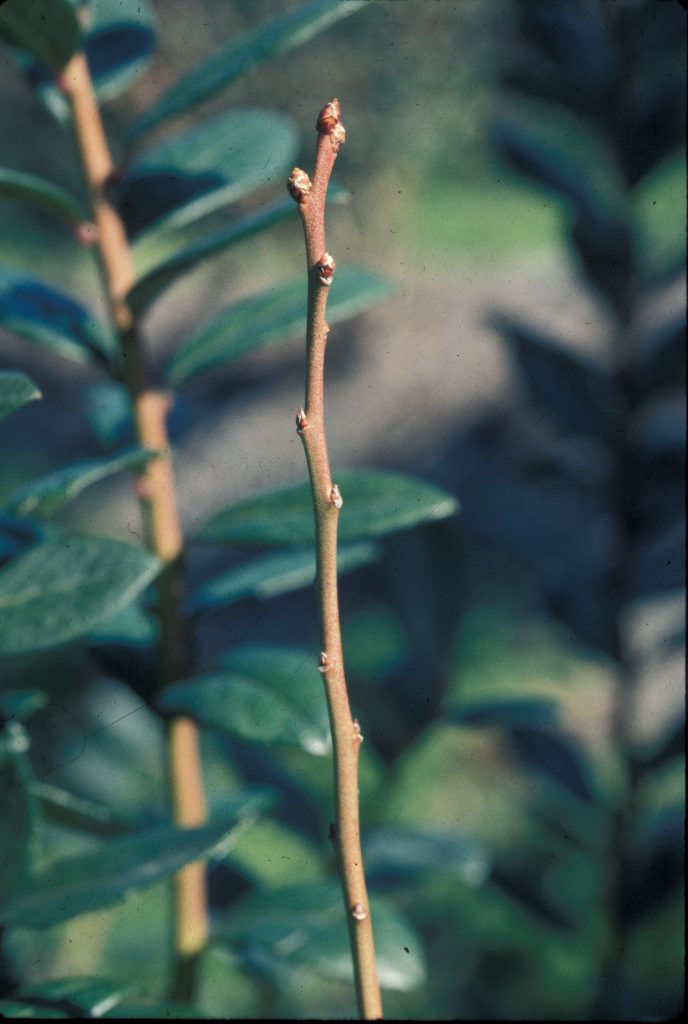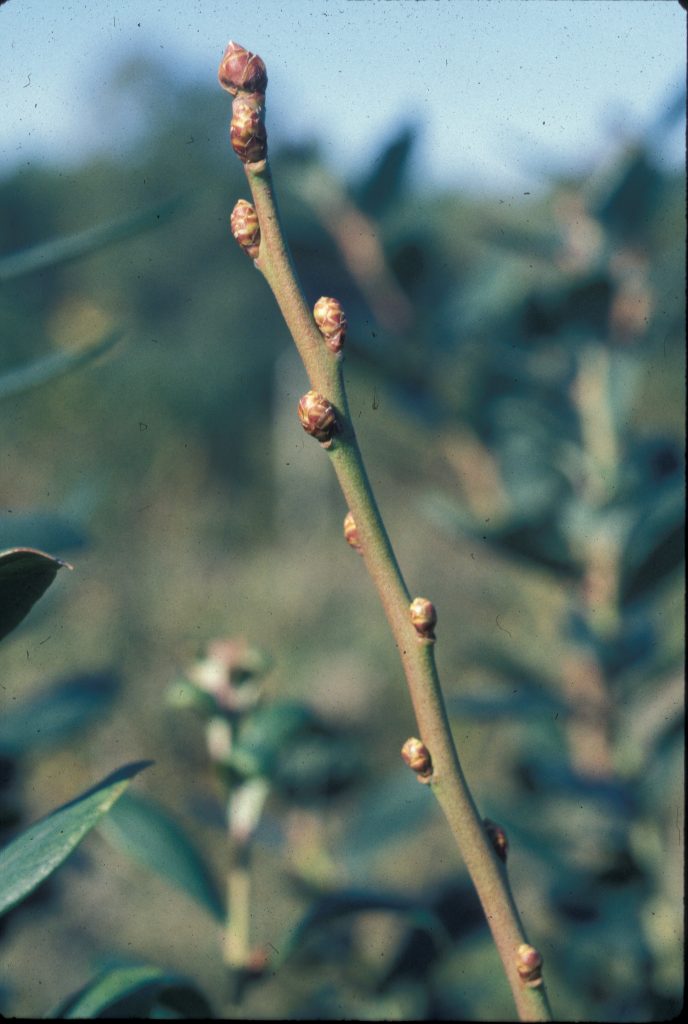By Jeff Williamson
As winter approaches, blueberry plants respond to the changing environment in ways that should be addressed through management practices. Shorter days and cooler nights are environmental cues that stimulate changes in blueberry plant growth and development, such as terminal bud set and the cessation of shoot extension growth, the initiation and development of flower buds, the onset of dormancy, acquisition of cold hardiness and accumulation of winter chilling (in deciduous production systems).

FLOWER
BUD DEVELOPMENT
Most flower buds
develop during the late summer or fall on the summer growth shoots that
developed following postharvest pruning, although some flower buds may be
located lower in the canopy on spring flush wood. The exact time of flower bud
initiation varies with cultivar. For example, Emerald plants usually begin developing
flower buds in August, while Jewel plants will not usually begin significant
flower bud development until early October.
The initiation and development of flower buds begins on the terminal ends of shoots and proceeds down the cane and continues for a period of weeks as axillary vegetative buds are converted to flower buds. Leaves are photoreceptors that can sense the shortening daylengths, and research has shown that they must be present for normal initiation and development of flower buds.
Early fall defoliation can result in reduced flower bud initiation and development (Figure 1 and Figure 2). Therefore, it is important to provide a sound leaf disease management program throughout the summer and into the fall. Furthermore, if the evergreen production system is used, it is imperative to keep the foliage healthy and disease-free through the winter since these leaves are supporting the early crop the following year. Disease-infected leaves from the previous fall can serve as a source of inoculum for disease development on the new spring growth.
DECIDUOUS
VS. EVERGREEN
Some fall management practices will vary depending on whether the grower
employs the traditional deciduous system or the evergreen system. The deciduous
system requires plants to go through a winter dormancy during which they are
exposed to chilling temperatures at or below 45 degrees. Once enough chilling
has occurred (which varies by cultivar), growth will resume after exposure to
warm temperatures.
With the traditional deciduous production system, fertilizer applications usually cease in late summer to prepare plants for dormancy. However, with the evergreen production system, plants do not enter winter dormancy and will resume growth when temperatures are warm enough without the requirement of chilling temperatures. With the evergreen production system, growers continue to provide fertilizer throughout the fall at a reduced rate so that shoot extension growth stops, but plants will not defoliate or enter dormancy.

HYDROGEN
CYANAMIDE
A major concern for
Florida growers who use the traditional dormant production system is insufficient
winter temperatures cold enough to satisfy chilling requirements, even for
low-chill blueberry cultivars. Hydrogen cyanamide (HC), including Dormex and
BudPro, is often used by conventional (non-organic) growers to ameliorate the
negative effects of insufficient chilling. HC can assist under-chilled blueberry
plants by stimulating an earlier and stronger leaf growth flush and a more
concentrated bloom period than would otherwise occur.
Not all southern highbush cultivars respond well to HC treatment. For example, Emerald and Farthing are generally considered HC-tolerant and may benefit from HC sprays. Other cultivars, such as Jewel and Primadonna, have been damaged by HC sprays. Individual cultivars vary in their response to HC and should be tested prior to large-scale use.
In general, response to HC treatment has been erratic, and more flower bud injury has been observed in Central Florida than in North Florida, especially following mild winters. When considering using HC, many factors come into play. These include application timing, application rate and cultivars treated. For more information on this topic, see Table 17 in the 2019 Florida Blueberry Integrated Pest Management Guide and Reproductive Growth and Development of Blueberry.
IRRIGATION
ADJUSTMENTS
Irrigation rates should
be adjusted for the fall and winter. As days become shorter and cooler,
blueberry plants use less water. Research in Florida has shown that average
water use by blueberry plants declines significantly during October compared to
September. For example, Emerald blueberry plants in north-central Florida that
were grown under the traditional dormant production system used only about 60
percent as much water in October as they did in September.
Water use continues to decline during November, December and January. Therefore, irrigation programs should be adjusted to the changing weather conditions during fall and winter. Carefully monitor soil to maintain adequate moisture needed for healthy roots and to prevent drought stress. Where foliage persists throughout the fall and winter, as in the evergreen production system, evapotranspiration demands will be higher than in the deciduous system, and irrigation programs should be adjusted accordingly.
Jeff Williamson is an Extension specialist in the Horticultural Sciences Department of the University of Florida Institute of Food and Agricultural Sciences.
This article was featured in the October issue of VSCNews magazine. To receive future issues of VSCNews magazine, click here.









